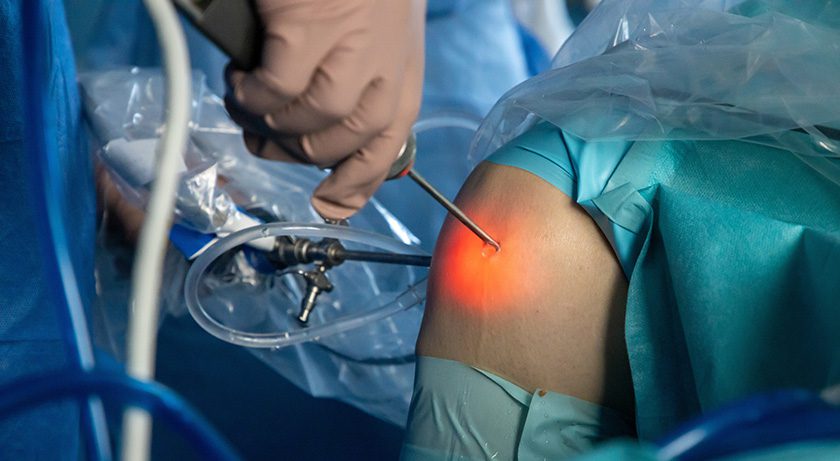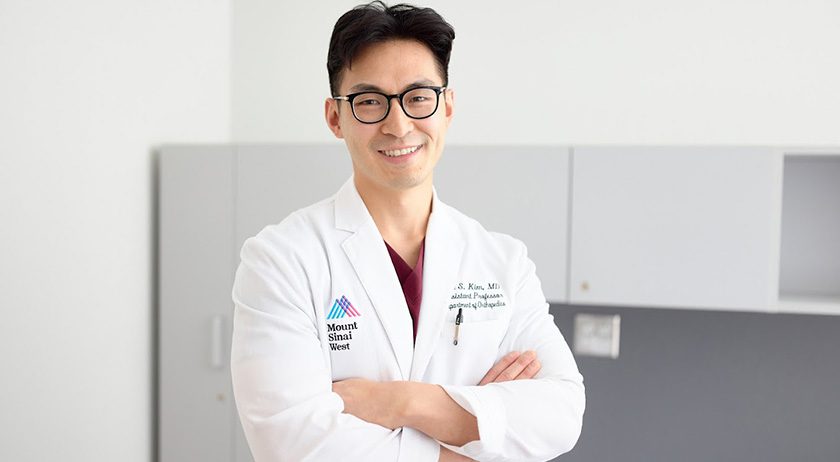

 Copy to clipboard
Copy to clipboard 
Bone Solutions launched OsteoCrete magnesium oxide-based bone void filler in 3Q17. The product was cleared by FDA in 2009 and remains the only bone void filler on the U.S. market to use magnesium, according to company Chief Executive Officer Drew Diaz.
We spoke with Mr. Diaz, an ORTHOWORLD Member, on several topics ranging from data collection to struggles for startups and the future of orthopaedic technology.
Data Rules
ORTHOKNOW: OsteoCrete’s U.S. launch was years in the making. What surprised you—good and bad—about the process?
Mr. Diaz: What surprised me first was the number of physicians who were willing to evaluate OsteoCrete because of the data that has been accumulated over time. Second was the complexity for a hospital to approve the product so that it can be allowed into that institution. There are a lot of great products in the market today, but because of changing healthcare economics and protocols, it is becoming more and more rigid and difficult—even though they may be better technology or better products overall—to get them into the hospital. This has everything to do with healthcare economics, trying to save as much money as possible.
ORTHOKNOW: Following up on your second point, what questions are hospitals asking you?
Mr. Diaz: The first question is: Is it more expensive? Which I think is shortsighted. As we know with regard to patient outcomes, you may have a very inexpensive product on the front end that may become expensive on the back end. The second question is about the supporting data. Thankfully, we do have supporting data. Hospitals have to look at patient outcomes from an entirely different perspective, meaning it’s not just the procedure the patient is in the hospital for, and the short term patient care. Now we have to look at patient outcomes one month, three months, six months and 12 months after the procedure. We don’t want that patient to be readmitted for revision surgery.
ORTHOKNOW: So, what was the most important lesson learned?
Mr. Diaz: Patience! The most important thing I have learned in the last 15 years of my professional career is that there is only one god in medicine and that god’s name is data. Without data, you’re not going to get far. Data is by far the most important variable to address for success.
ORTHOKNOW: What advice can you offer on collecting data?
Mr. Diaz: Many institutions want to contribute data, but there is sometimes a small difference between significant and insignificant data. It takes a team to understand the goal and the true purpose of the company, to determine what type of data they need. In short, data can be accumulated all day long from many institutions. But is it good data or insignificant data? We always want to pursue significant data. And significant data demonstrates positive impacts to the viability of the technology and the patient outcome.
Launch Prep
ORTHOKNOW: Has the data collection been a big part of what’s taken place since getting clearance in 2009?
Mr. Diaz: Yes, amassing data; we’ve published more studies, but also finding the right manufacturing process and the right company to make OsteoCrete on a large-scale basis. Creating a product in a laboratory does not mean that it is easily recreated and scalable for mass production. Going from R&D in a lab to large-scale production is a unique stepping stone in a company’s life, because the manufacturing process may significantly differ from creation process that happened in R&D.
Another impact was funding. From 2009 to 2013, the economy was very, very difficult and it was hard to fund products like ours that were considered high-risk investments.
ORTHOKNOW: What advice would you give to leaders at startups who are commercializing their first products?
Mr. Diaz: My advice is to make sure you are fully funded. Whatever your funding projections might be, always add more. In medicine today, there are so many financial, regulatory and clinical hurdles. A company is handicapped from the beginning if it’s not properly funded. For anybody with a startup, make sure you are properly funded, number one. Number two, make sure you truly understand the competitive environment. There are many good products that never get a fair entrance into the marketplace because other products that may be inferior are successful due to their cost—healthcare economics.
ORTHKNOW: Knowing all of this, how have you prepared for OsteoCrete’s launch?
Mr. Diaz: The best we could with the resources that we have. You reach out to institutions and physicians that you consider to be approachable and patient. I use the word patient carefully, because nothing is perfect when you launch. I’ve never heard of any company that knew all the answers at launch time, because there are just some unknowns. Because of that, you want to make sure you approach institutions and physicians that are patient and willing to go through the launch process with you. We’ve been fortunate that we’ve found that.
Technology Talk
ORTHOKNOW: Are other companies pursuing magnesium-based bone void fillers?
Mr. Diaz: There are other companies pursuing this. Medtronic recently put in a patent for a product that contains magnesium. Magnesium-based products for orthopaedics are heavily, heavily investigated and researched right now through various institutions and companies.
Nothing has been FDA-cleared or is in the marketplace in the U.S. In Europe, there is a company that has a product that has magnesium in it.
Can I share one more thing about the technology?
ORTHOKNOW: Please.
Mr. Diaz: I feel strongly that the future of orthopaedics will be 100% resorbable materials. Not just resorbable materials, but materials that have compression strengths and tensile strengths similar to the most commonly-used materials in the industry today, mainly PEEK and titanium. I truly believe that in the very near future, we will see resorbable implants replace existing non-resorbable technologies. That’s what every company is pursuing.
Anything that can be resorbed by the human body and replaced by human tissue is preferred over something that is put into the body and left there for the rest of your life. The technology today is in the small, non-load-bearing implants, but I think in the next decade we’re going to see screws and rods that become human tissue.
ORTHOKNOW: Are resorbable technologies part of Bone Solutions’ pipeline?
Mr. Diaz: Our next project will be to form a bridge between non-resorbable and resorbable materials. We are working with a few concepts that combine the two, so that we can bridge the gap before we come up with a fully-resorbable technology that is load-bearing.
Bone Solutions launched OsteoCrete magnesium oxide-based bone void filler in 3Q17. The product was cleared by FDA in 2009 and remains the only bone void filler on the U.S. market to use magnesium, according to company Chief Executive Officer Drew Diaz.
We spoke with Mr. Diaz, an ORTHOWORLD Member, on several topics ranging from data collection...
Bone Solutions launched OsteoCrete magnesium oxide-based bone void filler in 3Q17. The product was cleared by FDA in 2009 and remains the only bone void filler on the U.S. market to use magnesium, according to company Chief Executive Officer Drew Diaz.
We spoke with Mr. Diaz, an ORTHOWORLD Member, on several topics ranging from data collection to struggles for startups and the future of orthopaedic technology.
Data Rules
ORTHOKNOW: OsteoCrete’s U.S. launch was years in the making. What surprised you—good and bad—about the process?
Mr. Diaz: What surprised me first was the number of physicians who were willing to evaluate OsteoCrete because of the data that has been accumulated over time. Second was the complexity for a hospital to approve the product so that it can be allowed into that institution. There are a lot of great products in the market today, but because of changing healthcare economics and protocols, it is becoming more and more rigid and difficult—even though they may be better technology or better products overall—to get them into the hospital. This has everything to do with healthcare economics, trying to save as much money as possible.
ORTHOKNOW: Following up on your second point, what questions are hospitals asking you?
Mr. Diaz: The first question is: Is it more expensive? Which I think is shortsighted. As we know with regard to patient outcomes, you may have a very inexpensive product on the front end that may become expensive on the back end. The second question is about the supporting data. Thankfully, we do have supporting data. Hospitals have to look at patient outcomes from an entirely different perspective, meaning it’s not just the procedure the patient is in the hospital for, and the short term patient care. Now we have to look at patient outcomes one month, three months, six months and 12 months after the procedure. We don’t want that patient to be readmitted for revision surgery.
ORTHOKNOW: So, what was the most important lesson learned?
Mr. Diaz: Patience! The most important thing I have learned in the last 15 years of my professional career is that there is only one god in medicine and that god’s name is data. Without data, you’re not going to get far. Data is by far the most important variable to address for success.
ORTHOKNOW: What advice can you offer on collecting data?
Mr. Diaz: Many institutions want to contribute data, but there is sometimes a small difference between significant and insignificant data. It takes a team to understand the goal and the true purpose of the company, to determine what type of data they need. In short, data can be accumulated all day long from many institutions. But is it good data or insignificant data? We always want to pursue significant data. And significant data demonstrates positive impacts to the viability of the technology and the patient outcome.
Launch Prep
ORTHOKNOW: Has the data collection been a big part of what’s taken place since getting clearance in 2009?
Mr. Diaz: Yes, amassing data; we’ve published more studies, but also finding the right manufacturing process and the right company to make OsteoCrete on a large-scale basis. Creating a product in a laboratory does not mean that it is easily recreated and scalable for mass production. Going from R&D in a lab to large-scale production is a unique stepping stone in a company’s life, because the manufacturing process may significantly differ from creation process that happened in R&D.
Another impact was funding. From 2009 to 2013, the economy was very, very difficult and it was hard to fund products like ours that were considered high-risk investments.
ORTHOKNOW: What advice would you give to leaders at startups who are commercializing their first products?
Mr. Diaz: My advice is to make sure you are fully funded. Whatever your funding projections might be, always add more. In medicine today, there are so many financial, regulatory and clinical hurdles. A company is handicapped from the beginning if it’s not properly funded. For anybody with a startup, make sure you are properly funded, number one. Number two, make sure you truly understand the competitive environment. There are many good products that never get a fair entrance into the marketplace because other products that may be inferior are successful due to their cost—healthcare economics.
ORTHKNOW: Knowing all of this, how have you prepared for OsteoCrete’s launch?
Mr. Diaz: The best we could with the resources that we have. You reach out to institutions and physicians that you consider to be approachable and patient. I use the word patient carefully, because nothing is perfect when you launch. I’ve never heard of any company that knew all the answers at launch time, because there are just some unknowns. Because of that, you want to make sure you approach institutions and physicians that are patient and willing to go through the launch process with you. We’ve been fortunate that we’ve found that.
Technology Talk
ORTHOKNOW: Are other companies pursuing magnesium-based bone void fillers?
Mr. Diaz: There are other companies pursuing this. Medtronic recently put in a patent for a product that contains magnesium. Magnesium-based products for orthopaedics are heavily, heavily investigated and researched right now through various institutions and companies.
Nothing has been FDA-cleared or is in the marketplace in the U.S. In Europe, there is a company that has a product that has magnesium in it.
Can I share one more thing about the technology?
ORTHOKNOW: Please.
Mr. Diaz: I feel strongly that the future of orthopaedics will be 100% resorbable materials. Not just resorbable materials, but materials that have compression strengths and tensile strengths similar to the most commonly-used materials in the industry today, mainly PEEK and titanium. I truly believe that in the very near future, we will see resorbable implants replace existing non-resorbable technologies. That’s what every company is pursuing.
Anything that can be resorbed by the human body and replaced by human tissue is preferred over something that is put into the body and left there for the rest of your life. The technology today is in the small, non-load-bearing implants, but I think in the next decade we’re going to see screws and rods that become human tissue.
ORTHOKNOW: Are resorbable technologies part of Bone Solutions’ pipeline?
Mr. Diaz: Our next project will be to form a bridge between non-resorbable and resorbable materials. We are working with a few concepts that combine the two, so that we can bridge the gap before we come up with a fully-resorbable technology that is load-bearing.

You are out of free articles for this month
Subscribe as a Guest for $0 and unlock a total of 5 articles per month.
You are out of five articles for this month
Subscribe as an Executive Member for access to unlimited articles, THE ORTHOPAEDIC INDUSTRY ANNUAL REPORT and more.
CL
Carolyn LaWell is ORTHOWORLD's Chief Content Officer. She joined ORTHOWORLD in 2012 to oversee its editorial and industry education. She previously served in editor roles at B2B magazines and newspapers.







